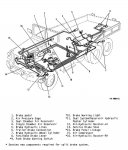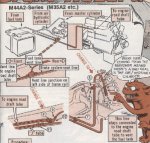QUADJEEPER
Member
- 797
- 8
- 18
- Location
- Winter Springs, FL
Yes, even printed it out. But doesn't clearly show the trailer circuit (s) from the airpacks.
Steel Soldiers now has a few new forums, read more about it at: New Munitions Forums!

Yes, even printed it out. But doesn't clearly show the trailer circuit (s) from the airpacks.

Yes I know zout. But a shortage of money and motivation tends to hamper progress.Quad - I sure hope your done dinking around with your project to bring it to the GA Rally 2015 - step it up a notch there brother - time is a wasting.
You can use the SMARPI manual and the A3 one. Look here starting around PDF page 251 for how to plumb the air lines on the dual circuit setup.Yes, even printed it out. But doesn't clearly show the trailer circuit (s) from the airpacks.
Unfortunately a dollar a day is about $250. Need to add a zero to that for it to even be of any help.From here and where your at - save that $1 a day in chump change and bring er on to show it off - you deserve it for the hard work - now get back to work.

Oh I feel the love!

Thanks Ray, but not the hot rod that yours is!Great running truck Scott! Loved the power steering!

Thanks, I just try to do it right. Not always successful. I'd like to see it done too.This is an amazing build. Your cab wiring is impressive. Wish I could do half that good. Looking forward to seeing the project completed.
What you need is some mouses pulling for you; then it'd be all done:Thanks, I just try to do it right. Not always successful. I'd like to see it done too.
Does any of this help?I am planning on adding two more air tanks to the system, plumbing them seems fairly straight forward. However not sure how the trailer brake line should be set up. From both airpacks with a tee, or just from one? Any input would be appreciated.
 View attachment deuce dual brakes MC bracket.docView attachment M35A2 brakes SMARPI9-2320-209-14P[1].pdfView attachment master cylinder bracket with PTO handle 02042014.docView attachment SMARPI9-2320-209-14P.pdfView attachment TM 9-2330-202-14&Ptrailer and surge brakes.pdf
View attachment deuce dual brakes MC bracket.docView attachment M35A2 brakes SMARPI9-2320-209-14P[1].pdfView attachment master cylinder bracket with PTO handle 02042014.docView attachment SMARPI9-2320-209-14P.pdfView attachment TM 9-2330-202-14&Ptrailer and surge brakes.pdf
Thanks Tim for your input. My idea was to install a set of OEM tanks like the originals, split the feed from the compressor into the two sets, then run the 2nd airpack off of the newly installed set. My question ( one of many) is should there be check valves after the "Y" from the compressor and before the tank sets. If I run the tanks in that configuration, I'd have two wet tanks and two dry tanks. Had thought of the longer pressure build time, but other than longer compressor cycles, didn't see an issue. No MV inspections per se in my state. If I drain both wet tanks daily, is an air drier critical? OEM on the deuce didn't have them, trying to stay simple as possible. I do drain every day of use. Still have the unanswered question about how the trailer air should be connected on a dual air pack system.Not sure how "correct" you want to keep your air system if you're adding a tank or two...
I am a fan of the modern air system desings, a "wet" tank before the other tanks seems like the way to go (AirCompressor-->AirDryer-->"WetTank"-->OtherTanks). I also like the 95psi cracking pressure check valves on the accessory tank(s), these prevent air from moving from the accessory tank to the wet tank like a normal check valve, but they also have a calibrated spring on the check ball that keeps it seated if the supply pressure is lower than 95psi. Using a low cracking pressure check valve on your brake reservoirs keep precious air pressure from returning to the Wet Tank of a hose breaks anywhere before the brake tank, and also with the low cracking pressure, ensures that the earliest air pressure built-up by the compressor gets to your brakes.
For example, on an Urban Transit Bus, it's not unusual to see no fewer than three tanks with 4 being more common with newer designs: Wet, Primary, Secondary, Accessory
If you're adding volume one caution - your air system is designed to reach pressure with a certain amount of time while the engine is at low idle. If you add tanks you are increasing the run time of the air compressor (take longer to fill more space), if you are in a state where air systems attached to brakes are inspected a slow build time could cause you to fail. Longer run times without an air dryer also increases the creation of condensation when the air it released (high pressure air can entrap more moisture, so as the air molecules spread out the moisture can consolidate into larger clumps making drops).
Adding an air dryer and increasing the size of your air compressor might be required for safe operation of your truck if you add air tank volume...


